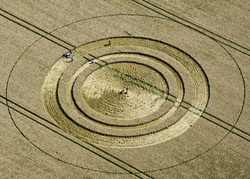 Submitted by Gemini on
Submitted by Gemini on

By Crop Circle Wisdom
http://www.cropcirclewisdom.com
What is a ghost circle ?
Ghost circles are imprints of previous seasons crop circles which sometimes reappear the following year in different crop. Due to a belief that crop circles are created by paranormal forces the believer automatically assumes that the paranormal force/energy is responsible for the reappearance of previous seasons crop circle.
Here are some factors for your consideration ( all our research is based on actual findings rather than assumptions - all factors are very important for you to consider if you are a serious researcher who has no vested interest and seeks the real truth ).
Canola / Rape Seed Crop Circles
Very rarely or if at all will you see a ghost circle appear in next seasons crop if a crop circle was made the previous season ( year before ) in Canola. So if the field is planted with wheat the following season then it is highly unlikely that a ghost circle will appear. If a crop circle was made in wheat and Canola is planted in the same field for the following season then there is a high chance that a ghost circle will appear if no action is taken to prevent it. ( We will explain ! )
Canola crop circles tend to appear in April / May - during these months the Canola plant is maturing and blooming into its striking yellow colour but as yet no seed which can germinate is produced by the plant. The maturity of seed production begins when the plant begins to shed its yellow petals - at this stage crop circle makers tend to avoid making crop circles as the petal less appearance isn't as striking as it would be in blooming Canola. At this stage in growth plant stems become like branches so making crop circles at this stage in maturity would take some determined effort, but as its hard work and not as striking in appearance then circle makers will avoid using this crop and move onto the next which is generally Barley.
During the months of April and May crop circle tourism isn't at its highest so plant crushing footfall isn't as great as it would be in June/July and August. As Canola in April and May has as yet not produced germinating seed so there will be no seed to push back into the soil (which can germinate) by the foot of visiting public. However visitors do still visit old Canola crop circle formations during the seeding process, so plants that have not been snapped but flattened will still continue into maturity and seeding process, so visitors who unconsciously stand on a full head of seed are in fact replanting these seeds to grown again - please remember this factor .
Barley Crop Circles
Ghost Crop Circles can appear in next seasons crop if created in Barley the previous season but there are once again some factors to take into consideration.
Barley crop circles are generally created in young and still green barley but on occasions mature golden coloured barley can be used by the circle makers. If a crop circle is created in young and still green barley then the chances of a ghost circle appearing is slim as young barley has a very good recovery rate after its ordeal of being flattened. Sometimes within 7 days of a crop circle creation the crop circle may appear to have disappeared. If you happen to visit a crop circle in barley ( end of May and beginning of June ) and found that the flattened crop has substantially risen then the chances of a ghost circle are slim as no or very little trampling of seed back into the soil has occurred.
West Kennett, Nr Avebury, Wiltshire. Reported 25th July 2011

There is a good chance that this crop circle will produce a ghost circle in 2012 - depending of course if the farmer replants this field and how much nutrient he places in this affected section of the field !?.
Wheat Crop Circles
Crop Circles made in wheat are MOST LIKELY to produce a ghost circle for the following season if the farmer does not replace sufficient nutrient in the effected area.
Wheat crop circles are made at the end of June - in July and August. This part of the season will have the highest rate of crop circle tourism - plant crushing footfall will exceed over a thousand visitors per easy to access crop circles which are within popular locations. Locations such as East Field - South Field - Woodbrough Hill, Silbury Hill and Milk Hill are more likely to develop ghost circles than any other location. Other locations which produce ghost circles would require substantial footfall for a ghost circle to appear - in such cases the reason would be the popularity of a specific crop circle design where it attracts a high tourism demand.
OK - lets get to the nitty gritty and simplicity and explain to you why GHOST CIRCLES APPEAR !
Flattened to the ground crop such a wheat and barley has a head full of seed which will be stepped on when the hoards of infatuated crop circle pilgrims enter the standing walls of surrounding upright wheat. As the seed head is stepped on - the seed pops out of its pod - please consider that we are talking about several thousand seed heads ( kernels ) that will shed their seed when stepped on - a pound of wheat seed may contain as much as 10.000 grains ( If not more ! ).
So you the visiting public are unconsciously replanting this seed by forcing it into the soil with every footstep. So therefore this grain begins the germinating process once again !. Once the crop circle becomes uninteresting as its no longer the current one on crop circle connectors wall and footfall diminishes to a trickle then green shoots begin to appear within the flattened boundary of the crop circle design. ( This may happen before harvest or after harvest, all depends when the crop circle was made ). After harvest the young green shoots in effect have revitalised a harvested crop circle to appear once again and nice and green. This is not a miraculous conception as some would like to believe - this is just the grain going through its germinating and growing process which has been replanted by your foot !!!!
OK What Happens Next ?
The young shoots begin to draw ( suck up ) last of the nutrients from soil where harvested crop has already sucked up existing nutrients - thus making this region of poor soil quality.
So when farmers plough their fields they will either make a mental note or mark the area where a crop circle was made. This area will have to have a double dosage of fertilizer, manure and nutrients which has to ploughed back into the soil. Farmers who bother to treat this area ( at extra cost to them ) with a double dosage or more are more likely to avoid a ghost circle appearing. Farmers who simply plough their fields and apply equal amount of nutrients throughout the entire field with no extra nutrient applied to where the crop circle was then they are more likely to have a ghost circle in new planted crop in the next season. If the area where a crop circle was made is not treated with double dosage then next seasons crop will have less nutrient for equal growth - so plants with the crop circle boundary will grow slower and not equally as other plants within the field - hence giving that ghost effect.
Snow Ghost Circles
Why does snow melt in the area where a crop circle was made but not outside its boundary ?
Anyone who has some farming knowledge will be putting their hands up with the answer - but of course the crop circle community will persist to inform you that a miracle has indeed happened.
Lets go back a step or two and look at the farmer who has bothered to revitalise his soil with that double nutrient dosage to the affected area but first consider the diagram and text below.

Factor Acceptable Range Temperature 54 – 60 °C Carbon to Nitrogen ratio (C:N)25:1 – 30:1 Aeration, percent oxygen> 5% Moisture Content50 – 60% Porosity30 - 36 pH6.5 – 7.5
Temperature
Temperature is a very good indicator of the process occurring within the composting material. The temperature increases due to the microbial activity and is noticeable within a few hours of forming a pile as easily degradable compounds are consumed. The temperature usually increases rapidly to 50 - 60°C (122 - 140°F) where it is maintained for several weeks. This is called the active composting stage. Biochemical reaction rates approximately double with each 10°C (50°F) increase in temperature, yet higher temperatures will increase ammonia loss during the composting process. The temperature gradually drops to 40°C (104°F) as the active composting slows down and the curing stage begins. Eventually, the temperature will become that of the surrounding air.
The highest rates of decomposition occur when temperatures are in the range of 43 - 66°C (110 - 150°F). During the active composting stage, the temperature may start to fall because of a lack of oxygen. Turning the material introduces new oxygen and the active composting stage continues. The temperatures can exceed 70°C (158°F) but many microorganisms begin to die, which stops the active composting stage. Cooling the material by turning helps to keep the temperature from reaching these damaging levels. Heat loss occurs primarily because of water evaporation from the material. Heat loss can also occur if the pile is too small or is exposed to cold weather. If the moisture content falls too low it increases the chance of obtaining damaging high temperatures.
The temperature should be maintained at 55°C (131°F) or higher for a minimum of 14 days to destroy the viability of many pathogens and weed seeds. Remember, the edges of the windrow are cool, therefore they must be turned into the centre to kill the weed seeds.
Im sure most of you have seen a compost pile steaming on a cold winters day - so if you see snow melted in an old crop circle then be rest assured that this farmer has bothered to treat his soil with a extra helping of manure and soil nutrients. A higher concentration of manure will create a trickle of constant heat !!!!!
It has NOTHING TO DO WITH ALIENS I PROMISE YOU !
- 3988 reads